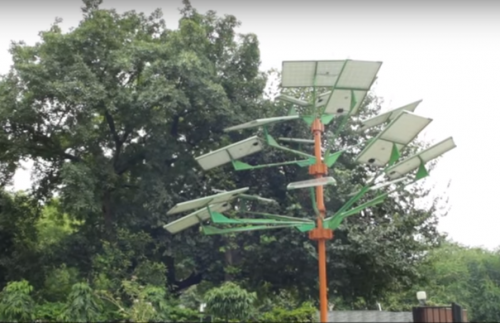Welcome, Friday , Apr , 26 , 2024 | 08:14 IST
Welcome, Friday , Apr , 26 , 2024 | 08:14 IST

Newsletter January 2019
Newsletter February 2019
PTI | 2 July 2019 6:36 PM GMT

HIGHLIGHTS
Kolkata (PTI): With water scarcity looming large across the globe, CSIR and Central Mechanical Engineering Research Institute (CMERI) of Durgapur on Tuesday announced the development of new technologies for supply of quality drinking water.
India is facing drinking water crisis and a Niti Aayog report has predicted that 21 cities of the country would have no drinking water of its own by next year.
Director of CSIR-CMERI Harish Hitani said that the new technologies developed are based on the principles of oxidation, precipitation and filtration. They do not require electric power and are completely green. The technpologies developed by CSIR-CMERI would be transferred to two private companies based in Haryana and Howrah in West Bengal.
"We have developed three technologies for serving quality drinking water from groundwater sources which is free from of contaminations arising out from the presence of iron, arsenic and fluoride", he told a news conference here.
Groundwater is a major source of drinking and agricultural usage in the country. But at a number of locations, contaminants such as arsenic, iron and fluoride in ground water exceed the permissible limits causing severe health hazards, he said.
"To solve such problems, CSIR-CMERI is continuously researching on water conservation as well as water filtration management. The technologies developed are ready for commercialisation" he added.

Team MP 2 July 2019 6:08 PM GMT
Kolkata: Central Mechanical Engineering Research Institute (CMERI) under Council of Scientific and Industrial Research (CSIR) has invented new technologies of purifying water contaminated with iron, arsenic and fluoride.
On Tuesday two private companies were handed over the technological details using which they will manufacture water purifiers for commercial and community purpose.
Professor Harish Hirani, Director of CMERI on Tuesday stated that keeping the water crisis in mind, their institute had taken up the project long time ago. After long research they have found the way to serve quality of drinking water. He said: "In India ground water is a major source of drinking and agricultural use. At a number of locations in rural as well as some urban India contaminants like arsenic, iron and fluoride in groundwater exceed the permissible limit causing health hazards.
Also, there is continuous depletion of ground water."
According to Hirani apart from purifying iron, arsenic and fluoride contaminated waters, CMERI has also invented technologies to recycle and purify sewerage water with intention to reuse for daily purpose other than drinking. But that technology is yet to get commercialised. Also installing the purifier is very easy with hand pumps in rural belts as it needs to be attached only. Hirani expressed his hope that in future these technologies will be popular and effective for water conservation across the country.
Solar trees need nearly 100 times less space to produce the same amount of electricity as a horizontal solar plant

The working of a solar tree is much like that of a real one—leaf-like solar panels connected through metal branches using sunlight to make energy.
Availability of land of installing solar panels on a large scale is often a hurdle in the progress of renewable energy. A solution to this is planting solar trees, which are more ergonomic, using little space. Solar trees are complementary to rooftop solar systems, or other green building measures, symbolizing these larger investments and their environmental benefit.
The Solar tree panels charge batteries during the day. At dusk, the tree automatically switches on LED lights. It is programmed to regulate the amount of light it produces. Solar trees are flexible and rotate to face the sun and produce maximum possible amount of energy using a technique called “spiralling phyllataxy”. Its calculated rotations allow even the lowermost solar panels to receive ample sunlight for electricity production. It can also be used in street lighting and industrial power supply systems.
Solar tree is made of metal structure and have solar panels at the top instead of branches of real tree. Main body of solar tree is a simple hollow tube closed at one end to enable the attachment of the upper, smaller rod which should carry the upper panel. This panel is placed high above the other panels at a vertical angle. The angle provides a constant area for the sunlight regardless of the sun trajectory during the day. The height at where it is placed enables a greater panel area which will not cover the lower placed panels.
The innovation is suitable for use in off-the-grid remote areas or in places that need point-sourced light like car parks and street lighting. Besides, with gird connectivity or battery store, the solar tree can also supply electricity wherever needed.
The plant’s design can vary according to different factors. In India, for instance, solar trees can contribute to fulfilling energy demand while saving space. The technology can ensure continuous supply of electricity in areas that do not have enough power supply and can benefit many who are not connected to the grid. Solar energy is renewable and clean in nature and presents a better alternative over other methods of electricity production.
Working models in India
Central Mechanical Engineering Research Institute (CMERI), in West Bengal’s Durgapur, has designed and developed, a solar tree that takes up only four square feet of space and produces about three kilowatts of power, enough to power about five households. Conventional solar photovoltaic systems occupy 400 square feet of space to produce the same amount of electricity.
Their working model could be fit onto rooftops and on highways due to its minimal space requirement. Apart from Durgapur, solar trees are also installed in Council of Scientific and Industrial Research, New Delhi and the residential campus of Minister of Science & Technology of India. The solar tree installation was also used by the Durgapur Municipal Corporation at its Srijani Auditorium. The tree has been designed and developed by Indian researchers. They claim that there is no barrier in using solar trees in urban or rural areas.
The vertical solar plant makes it possible to harness 10 per cent more sunlight. They can be rotated twice a day to be aligned to the movement of the sun. CMERI has licensed the solar tree with M/s Vibes Solar Solution India, Kolkata and the process is underway to license the technology to five more companies. Researchers at CMERI are working on bringing aesthetic models to suit the need of public parks, gardens and market places.
Vegetable Oil Market Research Report by Product Type (Palm Oil, Soybean Oil, Canola Oil, Peanut Oil, Olive Oil, Others), Packaging Type (Bottles, Pouches, Others), Distribution Channel (Store, Non-store), Region - Forecast till 2023
Market Overview
The ever-growing vegetable oil market is expected to grow further creating a deep revenue pocket. The pervasive growth of this market attributes to the rapidly growing population that prompts the growing need for the food. Moreover, factors such as the economic expansion in developing regions are escalating the market on the global platform.
Attributing to the globalization and growing urbanization people are increasingly becoming food enthusiasts and do not mind experimenting with different food culture. The growing number of applications and increasing use of vegetable oil in culinary uses, hydrogenated oils, industrial uses, and fuel are expected to foster market growth during the forecast period. Other factors supporting the market growth include the extensive use of vegetable oils in the burgeoning industries such as food & beverages, pharmaceutical, and cosmetic and personal care products. The emerging trend of converting vegetable oils into biofuels and energy is expected to drive the growth of the global vegetable oil market to an extent.
Get Free Sample Copy of “Vegetable Oil Market” @ https://www.marketresearchfuture.com/sample_request/6966
Energy conversion that envisages an increasingly important role for biofuels in the process of decarbonizing the planet. These plants that convert vegetable oil wastage into energy have significant potential to the circular economy while, reinforcing the use of waste, explicitly cooking oil, as an essential raw material for producing the innovative fuel Enidiesel+ and as a replacement for the edible raw materials that are currently used. On the other hand, factors such as the absence of regulatory laws are expected to impede the market growth over the review period. Nevertheless, efficient farming techniques and the extracting techniques developed by the market players which are effectively increasing the production of vegetable oil is estimated to support the market growth during the forecast period.
Major Players:
Key players leading the Global Vegetable Oil Market include
Industry/ Innovation/ Related News
January 28, 2019 ---- A research team from Kaunas University of Technology (Lithuania, Europe) and Vilnius University (Lithuania) published their study for converting vegetable oil into a material that can be used for 3D printing. The study published in Polymers journal indicates that this research is a promising step forward for the development of environmentally-friendly and sustainable polymers. Possible applications, due to avoidance of toxic ingredients, include 3D printed cell scaffolds, and nanophotonics.
The newly developed material - AESO (acrylated epoxidized soybean oil) is currently undergoing tests for its potential to replace petroleum-derived resins and has been shown to work without the use of a photo-initiator.
January 12, 2019 ---- A team of researchers from Council of Scientific and Industrial Research (CSIR – India) and Central Mechanical Engineering Research Institute (CMERI – India) announced the invention of a non-continuous biodiesel plant that can convert any vegetable oil (edible and non-edible) and animal fat to biodiesel.
With the invention of this plant, the cost of biodiesel production is estimated to be around INR 48 per liter when the average collection cost per liter of used Vegetable oil goes up to INR 40 per liter. Therefore, manufacturers can easily make a profit of INR 5 to 8/liter with a payback period of less than one year.
November 05, 2018 ---- Fuji Vegetable Oil Inc. (the U.S. arm of Fuji Oil Holdings Inc. (Japan) announced its plans to open a vegetable oil plant in the New Orleans area, Louisiana (the US). The project expected to be completed in June 2020 will be utilizing around USD 70MN funds. Fuji is planning to process palm kernel oil, palm oil, sunflower oil, and coconut oil in the complex that will also include storage and distribution facilities.
Market Segments
The MRFR analysis is segmented into four key dynamics for enhanced understanding.
Product Type: Soybean Oil, Palm Oil, Canola Oil, Peanut Oil, and Olive Oil among others.
By Packaging Type: Cans, Bottles, and Pouches among others.
By Distribution Channel: Store-based (Hypermarkets & Supermarkets, Convenience Stores, and others) and Non-store-based (on-line, eCommerce, and others)
By Regions: Asia Pacific, North America, Europe, and the Rest-of-the-World.
Access Full Report Details and Order this Premium Report @ https://www.marketresearchfuture.com/reports/vegetable-oil-market-6966
Regional Analysis:
The Asia Pacific region, heading with its flourishing agriculture industry is dominating the global vegetable oil market registering the highest CAGR. Furthermore, the presence of diverse cultures, as well as cuisines that promote the usages of a range of healthy oils, is fostering the growth of the regional market, creating a huge demand.
Also, factors such as the high population growth and the agriculture sector that has led to increased production and consumption of soybean oil in China and India and palm oil in regions of Indonesia and Malaysia are expected to drive the regional market growth during the forecast period.
Moreover, the increasing number of biodiesel and biofuel plants alongside the huge demand from the burgeoning industries such as F&B, Pharmaceuticals, and Personal care products propels the growth of the regional market.
The vegetable oil market in the European and North American region is expected to perceive moderate growth throughout the forecast period. The rapidly growing F&B, Pharmaceuticals, and Personal care products industries drive the growth of the markets in these regions. Spain & Italy among other European countries, stand the largest olive oil producing countries.
PTI Kolkata Updated: 13-09-2019 20:09 IST Created: 13-09-2019 20:09 IST
The Engineering Export Promotion Council Chairman Ravi Sehgal on Friday said the council's in- house technology centres at Bengaluru and Kolkata will help the launch of start-ups and create employment opportunities in the MSME sector. Sehgal also said the CSIR-CMERI, Durgapur, will play a major role in the MSME sector in reaching out the global market with their advanced manufacturing technologies and complete solution.
"The centres (in Bengaluru and Kolkata) would provide hands-on training to improve knowledge and skill of students and entrepreneurs. They will also help the launch of start-ups and create employment opportunities in the MSME sector," Sehgal said at a seminar on advanced manufacturing here. Addressing the seminar, Director of CSIR-Central Mechanical Engineering Research Institute (CMERI) Prof Harish Hirani said the manufacturing facilities at the institute have been augmented in terms of induction of manpower and machinery to provide complete design and manufacturing solution to MSMEs.
CMERI is the national level R&D Institute in the field of mechanical engineering and allied disciplines under the aegis of Council of Scientific & Industrial Research, Ministry of Science and Technology. Advanced Manufacturing Center of CSIR-CMERI is actively engaged in providing manufacturing technology solutions to engineering industries across the country, Hirani said at the seminar.
The seminar was jointly organized by the CSIR-CMERI, Durgapur and the EEPC India Technology Centre..
পসেইডন: 13 SEP 2019 4:10PM by PIB Kolkata
কলকাতা, ১৩ সেপ্টেম্বর, ২০১৯
কাউন্সিল অফ সায়েন্টিফিক অ্যান্ড ইন্ডাস্ট্রিয়াল রিসার্চ-সেন্ট্রাল মেকানিক্যাল ইঞ্জিনিয়ারিং রিসার্চ ইনস্টিটিউট (সিএসআইআর-সিএমইআরআই), দুর্গাপুর এবং ইইপিসি ইন্ডিয়া টেকনলজি সেন্টার আজ কলকাতায় উন্নত নির্মাণ প্রক্রিয়ার ওপর একটি আলোচনাচক্রের আয়োজন করেছিল। এই আলোচনাচক্রের উদ্বোধন করেন সিএসআইআর-সিএমইআরআই, দুর্গাপুরের নির্দেশক অধ্যাপক হরিশ হিরানি এবং ইইপিসি ইন্ডিয়ার-র চেয়ারম্যান শ্রী রবি সেহগল।
অধ্যাপক হরিশ হিরানি বলেন, বিশ্ব জুড়ে অর্থনৈতিক কর্মকাণ্ডের মেরুদণ্ডই হচ্ছে নির্মাণ শিল্প। আমাদের মতো দেশে এর মাধ্যমে কর্মসংস্থানের প্রচুর সুযোগ তৈরি হতে পারে। কিন্তু রপ্তানির পরিমাণ বৃদ্ধিতে নির্মাণ ক্ষেত্রের জন্য গবেষণা ও উদ্ভাবন অত্যন্ত জরুরি। এই লক্ষ্যে সিএসআইআর-সিএমইআরআই অতিক্ষুদ্র, ক্ষুদ্র ও মাঝারি শিল্পোদ্যোগীদের নির্মাণ প্রক্রিয়ার নকশা এবং বিভিন্ন সমস্যার সমাধান করতে জনগণ এবং যন্ত্রপাতির সমন্বয় প্রক্রিয়া নিয়ে কাজ করে চলেছে।
তিনি জানান, দুর্গাপুরের সিএমইআরআই-এর উন্নত নির্মাণ কেন্দ্র অতিক্ষুদ্র, ক্ষুদ্র ও মাঝারি শিল্পোদ্যোগ সহ বিভিন্ন ক্ষেত্রে আরও কর্মসংস্থানের সুযোগ তৈরি করার জন্য ছাত্রছাত্রী এবং শিল্পোদ্যোগীদের জন্য প্রশিক্ষণের ব্যবস্থা করেছে। তিনি আরও জানান, এই আলোচনাচক্রের মাধ্যমে শিল্পজগৎ এবং মেকানিক্যাল ইঞ্জিনিয়ারিং-এর সঙ্গে সংশ্লিষ্ট ব্যক্তিদের মাধ্যমে অভিজ্ঞতা, জ্ঞান এবং তথ্যের আদানপ্রদান হবে।
ইইপিসি-র চেয়ারম্যান শ্রী রবি সেহগল বলেন, কেন্দ্রীয় শিল্প ও বাণিজ্য মন্ত্রকের বিভিন্ন পরিকল্পনাকে ইইপিসি ইন্ডিয়া বাস্তবায়িত করে। বেঙ্গালুরুতে সংস্থাটি প্রশিক্ষণ কেন্দ্র তৈরি করেছিল যার একটি শাখা এখন কলকাতাতেও গড়ে তোলা হয়েছে। তিনি বলেন, আন্তর্জাতিক স্তরে উন্নত প্রযুক্তির মাধ্যমে নির্মাণ শিল্পের সুবিধার জন্য অতিক্ষুদ্র, ক্ষুদ্র, মাঝারি শিল্পোদ্যোগীদের সিএসআইআর-সিএমইআরআই, দুর্গাপুর গুরুত্বপূর্ণ ভূমিকা পালন করছে।
সিএসআইআর-সিএমইআরআই ‘স্বরাজ’ এবং ‘সোনালিকা’ ট্র্যাক্টর উদ্ভাবনের জন্য বিশেষ পরিচিত। কেন্দ্রীয় সরকারের বিজ্ঞান ও প্রযুক্তি মন্ত্রকের অধীন বিজ্ঞান ও শিল্প গবেষণা পর্ষদের আওতায় মেকানিক্যাল ইঞ্জিনিয়ারিং এবং তার সহায়ক শাখাগুলির গবেষণা ও উন্নয়নের কাজে এই সংস্থাটি গুরুত্বপূর্ণ ভূমিকা পালন করে।
Press Trust of India | Kolkata Last Updated at September 13, 2019 20:10 IST
The Engineering Export Promotion Council Chairman Ravi Sehgal on Friday said the council's in- house technology centres at Bengaluru and Kolkata will help the launch of start-ups and create employment opportunities in the MSME sector.
Sehgal also said the CSIR-CMERI, Durgapur, will play a major role in the MSME sector in reaching out the global market with their advanced manufacturing technologies and complete solution.
"The centres (in Bengaluru and Kolkata) would provide hands-on training to improve knowledge and skill of students and entrepreneurs. They will also help the launch of start-ups and create employment opportunities in the MSME sector," Sehgal said at a seminar on advanced manufacturing here.
Addressing the seminar, Director of CSIR-Central Mechanical Engineering Research Institute (CMERI) Prof Harish Hirani said the manufacturing facilities at the institute have been augmented in terms of induction of manpower and machinery to provide complete design and manufacturing solution to MSMEs.
CMERI is the national level R&D Institute in the field of mechanical engineering and allied disciplines under the aegis of Council of Scientific & Industrial Research, Ministry of Science and Technology.
Advanced Manufacturing Center of CSIR-CMERI is actively engaged in providing manufacturing technology solutions to engineering industries across the country, Hirani said at the seminar.
The seminar was jointly organized by the CSIR-CMERI, Durgapur and the EEPC India Technology Centre.
পসেইডন: 23 SEP 2019 6:29PM by PIB Kolkata
Scientists of CSIR-CMERI has come up with an affordable technological solution that saves significant amount of energy along with easy identification of faults in street lights named −Smart Dimmable LED Street Lighting Technology. The key feature of the technology is that it automatically increases the brightness of street lights when a pedestrian or bicycle or caris moving or present in the street and goes back to predefined diming state when none is present. The technology works in combination of the advanced motion sensors with dimmable LED drivers that makes on-demand dynamic lighting through adjustment of intensity of individual street lights that can varyfrom 10% to 100%. It softly enhances the brightness of forward lights so that the pedestrians or bicycles or cars get enough light well in advance. This ensures safety and comfort of pedestrian. Additionally, it automatically switches ON the street lights in the evening and OFF in the dawn, without the need for human intervention. Further, it is tolerant from undesirable trigger in light demand when animals such as cats, dogs etc., passes by.
CSIR-CMERI has transferred the Smart Dimmable LED Street Lighting Technology to M/s Koley Engineering Works, Howrah, WB on 21 September 2019.




